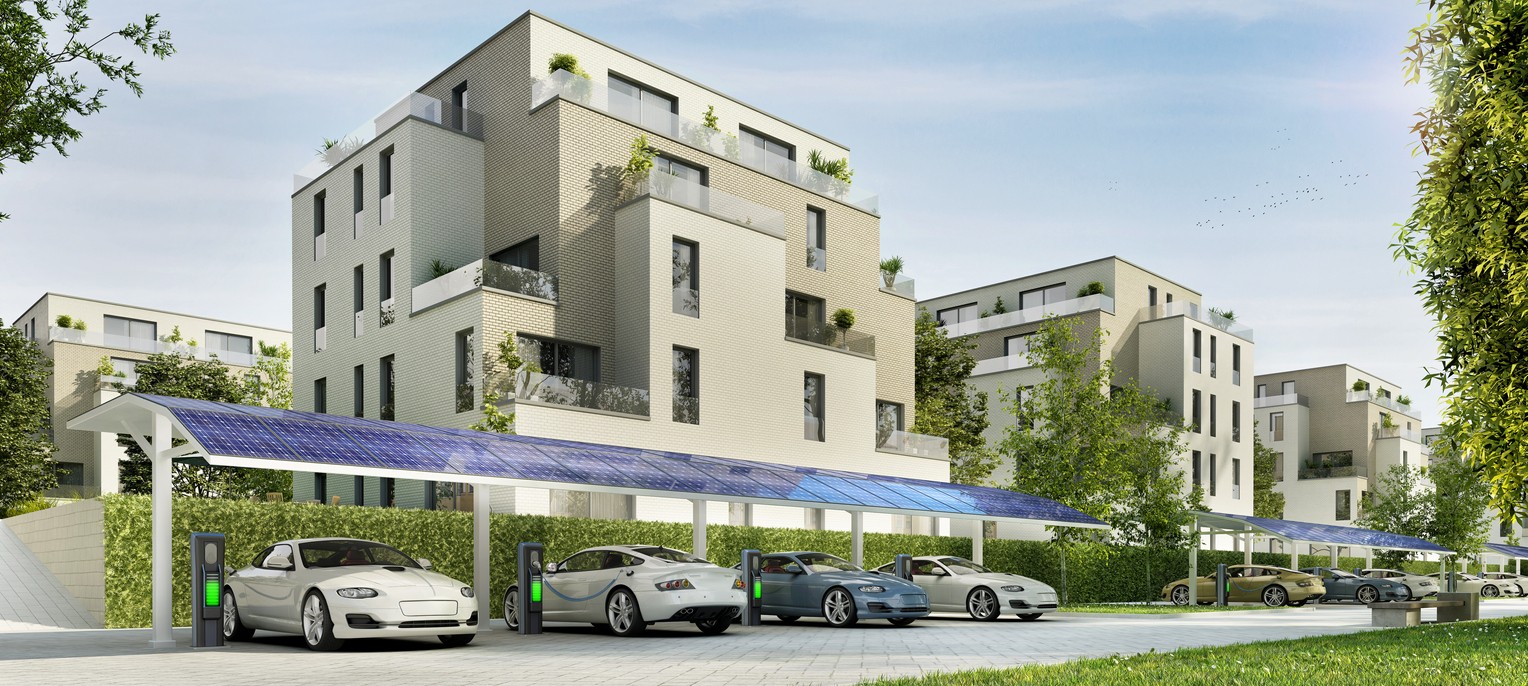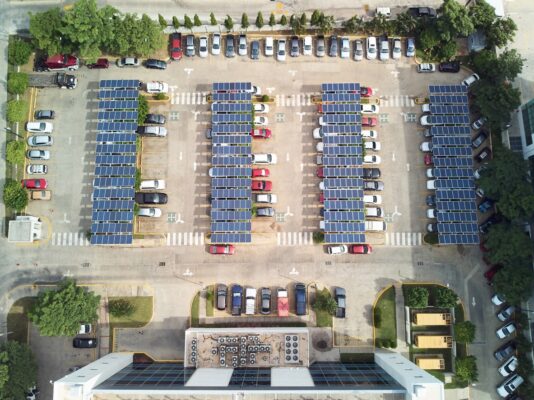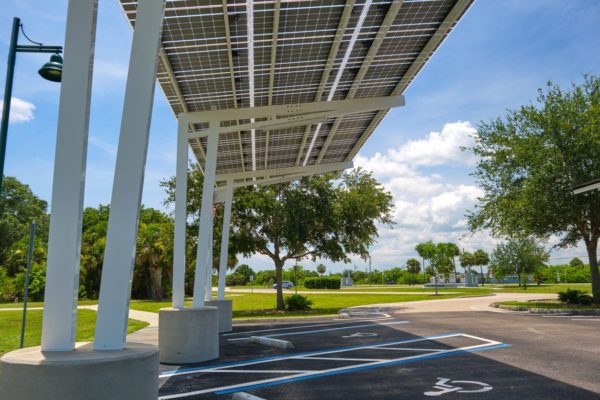
Does your business suffer from restrictions like insufficient roof space when installing solar panels? If yes, solar carports can help. Learn more about solar carports in this article, including what they are, how they operate, and how to find the best deals.
There is no denying that the solar energy industry is booming right now, with new businesses popping up everywhere. Chances are you have come across commercial solar systems for businesses, whether because you were actively looking into the advantages of solar energy or you spent any time on social media only to be inundated with solar advertising.
Solar energy is still an option even when installing rooftop solar panels is not the best course of action for a commercial enterprise. Solar panel carports are an emerging trend that businesses can use to leverage the space that covers a parking area.
Commercial parking lots are perfect for receiving solar energy since they are typically vast and open. Businesses can still benefit from solar energy by building solar panel carports over parking spaces. Find out if a solar panel carport is the best option for your company by reading about it.
Without installing solar panels on your roof, a solar carport could be a terrific method to acquire solar energy for your commercial property. Solar carports can shade people and vehicles while producing energy from the sun. While most solar systems are put on roofs, parking lots can also be a fantastic location for businesses to install a photovoltaic system and produce renewable energy.
What Is A Commercial Solar Carport?

A carport is a roof supported by beams or posts to protect the vehicles in the parking from harsh weather. Solar carports have solar panels that cover the carport’s roof to capture solar energy and convert it into energy for your business.
They can occasionally be set up to utilize sunlight more effectively than many roof-mounted solar systems. They employ a comparable technology to standard rooftop business solar panels. The energy generated by the solar panels is transformed into alternating current and added to the grid’s electricity supply.
Solar panel carports can provide convenient charging stations for electric vehicles (EVs) and shield automobiles from the sun’s ultraviolet rays and bad weather.
How Does a Commercial Solar Carport Work?
It is possible to convert your existing carport into a commercial solar carport. A solar carport is a taller version of a solar array attached to the ground. The solar panels will serve as the new structure’s roof, eliminating the need for one.
Solar carports employ the same solar energy technology as a regular ground- or rooftop-mounted system. When exposed to sunlight, carports transform photons into energy, which is then used to produce voltage or electric current in a photovoltaic cell. It is frequently referred to as the photovoltaic effect.
Although most solar carports are grid-connected, some freestanding off-grid solutions are also available. These also go by the name of solar canopies. Parking lots and other paved areas are frequently used as the location for solar canopies. Bifacial solar panels, which catch the light reflected from the ground, are another option.
Critical Considerations for a Commercial Solar Carport
Carport Size
When choosing the size of your carport, it is essential to strike a balance between installation costs, available space, and the amount of electricity you can produce. Overall, larger carports are more expensive to install, but the price per watt drops as size increases since some installation expenses are set and unaffected by the size of the system.
You should also consider how many panels broad your solar arrays for the carport will be. About one row of parking is covered by three solar panels placed together. Two parking rows can be covered by seven solar panels that are placed as one carport structure.
You can choose the optimum configuration based on your parking lot and energy requirements.
Clearance – The Space is below Your Solar Carport
When designing your solar panel carport with a solar contractor, you should consider how much space there is beneath the panels. The carport structure’s clearance needs to be high enough for equipment and cars to pass easily underneath. Making it too high, though, could unnecessarily drive up the price of your project.
Depending on the kind of cars you anticipate parking beneath the solar canopy, you will need to choose the ideal clearance height for your property. Businesses should aim for a deck height of at least 14 feet if they regularly expect heavy trucks and delivery vehicles to pass underneath.
A shorter carport might be an option for companies that primarily deal with vehicles and small trucks. Fire trucks and ambulances, which have higher clearance needs than small cars or trucks, might need passage around the carports.
Decking: Controlling Water Runoff
The primary advantage of a solar carport is the generation of cost-free, healthy electricity for your residence or business. However, there is one perk: easy-covered parking.
Cars and persons can be protected from the elements, such as the sweltering sun, rain, and snow, with the help of a solar panel canopy. However, you must install your carport system with decking to truly protect people underneath.
Decking, frequently composed of metal, is fastened to the vertical beams to create a sturdy roof. The solar panels are then fastened to the decking and mounted on the mounting structure. This sturdy coating prevents rain and water runoff from falling on the vehicles and people below. Depending on how the carport structure is laid out, it may have an additional cost, ranging from $0.20 to $0.25 per watt.
You can omit the decking and install the solar panels directly to the mounting framework, similar to how you would install them on a ground mount solar system, to cut expenses as much as feasible.
However, small gaps between the panels will allow water to puddle on persons and vehicles below. Additionally, melted snow will also fall if snow accumulation occurs. Downspouts or water management systems are additional options to consider. These components will aid in directing water away from the solar canopies and toward the proper drainage area.
You might be able to skip these if your carport is positioned so that the water drains and falls in a location that will not obstruct traffic. But the majority of medium- to large-scale carports make use of them.
Snow Guards: Preventing Snow Slides
You should consider adding snow guards to your solar carport if you reside in a region of the country where winters are predicted to be snowy.
The solar panels get covered in snow when it snows. This decreases their ability to generate electricity. Solar panels are therefore made to quickly warm up and shed this snow, exposing them to sunlight. Therefore, you will not need to physically wipe the snow off your panels.
What is excellent for your electricity bill is not suitable for those who use the walkways beneath the carports. Anyone strolling underneath may be at risk if the snow is allowed to fall off the panels in thick sheets.
Snow guards are helpful in this situation. These additions will stop significant snowfalls, protecting individuals below who are walking or driving.
Snow guards are always advised in places where snowfall is possible. The snow falling off the panels would land in the grass or another area where no one would be hurt. You might be able to avoid this if your carport installation is close to the border of your parking lot.
Lighting: Keeping Things Bright
A solar carport structure will render your current light posts obsolete if they are not already. However, providing adequate lighting for you and anyone who parks in your lot is still critical. Replacing old, ineffective lights with LED lights could be a significant additional benefit of a carport renovation.
Lighting can be installed under the carport to keep the parking areas well-lit and secure. This is critical if you are installing a larger solar carport system that will span two or more rows of parking spaces.
You might not need to install lights beneath a small carport that only covers one row of parking spaces.
What Are the Advantages of Commercial Solar Carports?

Commercial solar carports offer several benefits for your business. Here are the top advantages of installing a commercial solar carport.
Efficient Space Usage
No additional space is required to construct a carport; instead, an already existing area can be used to increase productivity and visitor, customer, and employee comfort.
In rainy and stormy weather, a carport can protect vehicles from the sun and keep them from overheating. Solar carports can help improve vehicle fuel economy by providing shade to keep cars from overheating in the sun.
Protection
Solar carports give businesses access to solar energy and a safe place to park their cars. For instance, the carport will shield the vehicle from the elements during bad weather, such as snow or sweltering sun rays.
On particularly hot days, the cool shades shield the automobile from the heat, perhaps saving on gasoline. What else? Carports can help collect rainwater apart from providing shade.
Better Power Generation
Another benefit is the installation angle of a solar carport above a conventional solar panel system. The amount of sunlight exposure, which affects energy output, is significantly impacted by the installation angle of solar panels.
There are restrictions on how much the panels can be tilted or even how they can be fastened for roof installations. On the other hand, solar carports are flexible and can be constructed to maximize energy output and exposure.
Coldwell Solar – Your One-Stop Solution for Commercial Solar Systems
Solar carports are a desirable choice due to their better efficiency. Suppose you value a cleaner, more comfortable car, clear windscreens, and the extra benefit of renewable energy. In that case, a solar carport is one of the best multi-purpose infrastructure improvements money can buy.
Like rooftop or ground-mounted solar panels, solar carports absorb photons from the sun and convert them into useful electrons. These electrons are then sent to an inverter, where they are transformed into AC electricity for use in the grid.
Solar carports stand out due to their versatility, which offers clean energy while protecting your car and freeing up space. Get in touch with Coldwell Solar for further guidance and top-notch commercial solar services.


